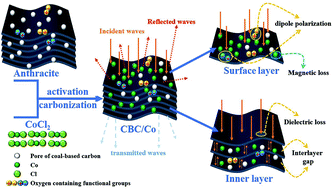In situ synthesis of layered coal-based carbon/Co porous magnetic composites with promising microwave absorption performance
Abstract
In this paper, light and ultra-thin coal-based carbon cobalt composites (CBC/Co) with excellent microwave absorbing properties were synthesized by using an in situ method from anthracite. The phase composition and chemical composition of the samples were characterized by using X-ray diffraction (XRD). Field emission scanning electron microscopy (FESEM) results indicated that the surface of the composite is covered with lamellar stripes that have a large number of macropores. Fourier-transform infrared spectroscopy (FT-IR) spectra showed that oxygen-containing functional groups in the CBC/Co composite gradually disappeared. The introduction of cobalt improved impedance matching of the composite. Since the CBC/Co composite has both dielectric loss and magnetic loss, it showed enhanced microwave absorption performance. The composite with a C/Co ratio of 1 : 0.12 showed the optimal microwave absorption performance, a minimum reflection loss of −57.05 dB at 10.48 GHz, and an effective absorption bandwidth of 2.8 GHz, at a thickness of only 2.13 mm. It is expected that the CBC/Co composite could be a new type of lightweight and high-performance electromagnetic wave absorbing material.



 Please wait while we load your content...
Please wait while we load your content...